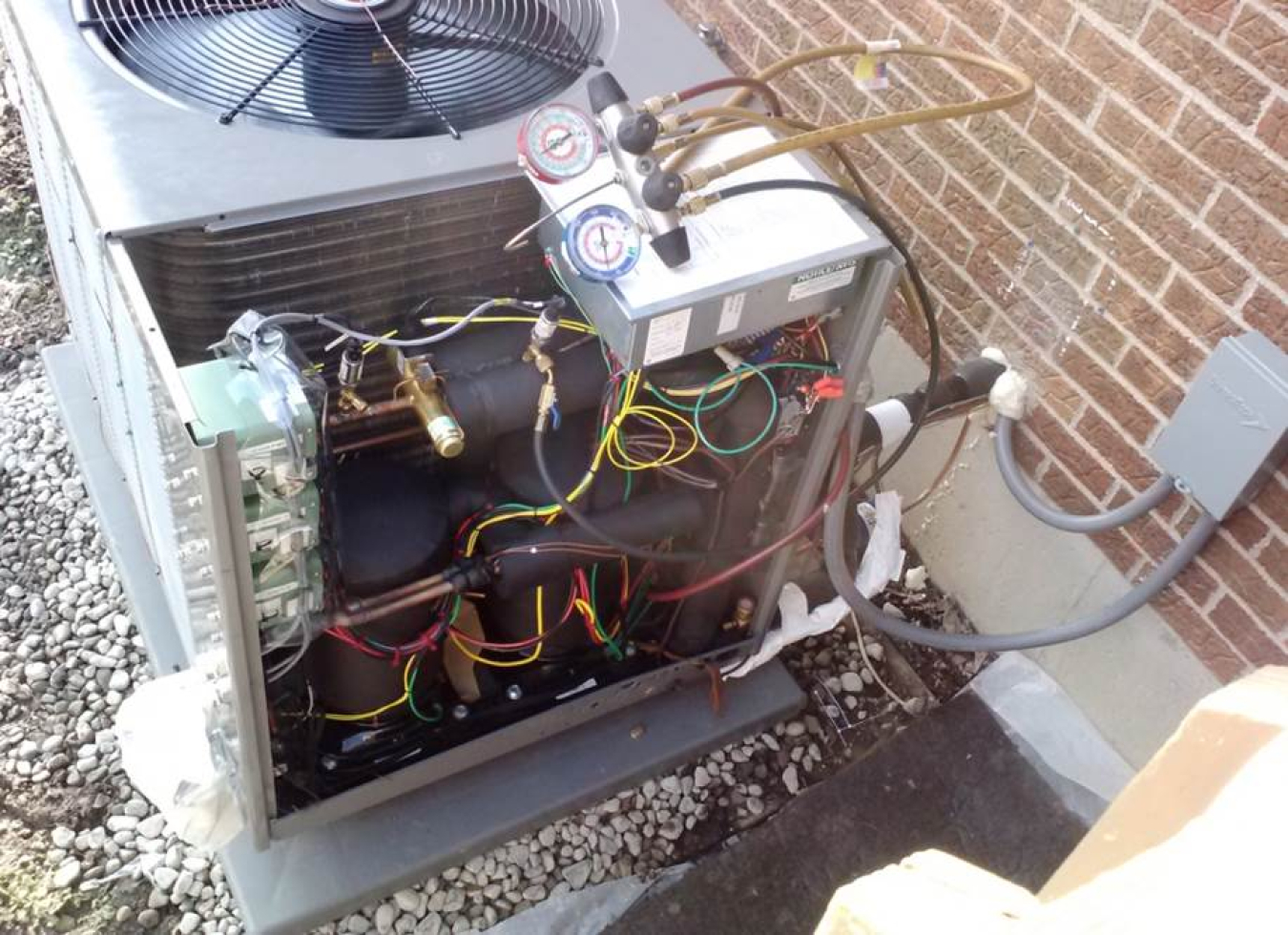
Photo of the prototype cold climate heat pump outdoor unit, installed at the Ohio field test site in January 2015. <br />Credit: Oak Ridge National Laboratory
Lead Performer: Oak Ridge National Laboratory - Oak Ridge, TN
Partners:
-- Unico Inc. - St. Louis, MO
-- Emerson Climate Technologies - Sidney, OH
DOE Funding: $2,839,000
Cost Share: Provided by CRADA partners
Project Term: March 1, 2012 - February 28, 2016
Project Objective
This project is developing a split-system, cold climate heat pump (CCHP) that provides a nominal heating capacity of 36,000 Btu/hour (3 tons) with a COP of 4.0 at the 47°F ambient temperature standard rating condition. In addition, heating capacity at -13°F ambient conditions is to be ≥75% of the nominal capacity. ORNL will perform an assessment study of cost-effective strategies for improving the performance of cold climate heat pumps. The assessment will rely on system modeling tools as well as actual cost figures based on manufacturer data. ORNL will assist Unico with analyses for component selection and sizing and prototype performance verification testing under the companion project Residential Cold Climate Heat Pump with Variable Speed Technology. ORNL will work with Emerson Climate Technologies on the development of a high-performance CCHP based on the cost-effective strategies identified in the assessment. Furthermore, ORNL and Emerson will jointly design and construct lab breadboard and field test prototype units for cold climates. The key performance metrics of a lab breadboard unit will be verified by laboratory testing. The heat pump field testing will be conducted in one or two U.S. cold climate zones, to demonstrate the energy saving potential in comparison to strip heating.
Project Impact
In the United States, approximately 14.4 million dwellings use electricity for heating in very cold and cold regions, consuming 0.16 quads of energy annually. A high-performance CCHP would result in significant savings over current technologies (greater than 70% compared to strip heating). The CCHP can result in annual primary energy savings of 0.04 quads when fully deployed, which is equivalent to a reduction of 2.4 million tons of annual carbon dioxide emissions.
Contacts
DOE Technology Manager: Tony Bouza
Performer: Bo Shen, Oak Ridge National Laboratory
Related Publications
- Bo Shen, Omar Abdelaziz, Van Baxter and Keith Rice, 2016, “High Performance Cold Climate Heat Pump (CCHP) – Final Report,” ORNL Report, ORNL/TM-2015/784
- Bo Shen, Omar Abdelaziz, Keith Rice, Van Baxter and Hung Pham, “Cold Climate Heat Pumps Using Tandem Compressor,” Conference Paper in 2016 ASHRAE Winter Conference
- Van Baxter, Eckhard Groll and Bo Shen, 2014, “Air Source Heat Pumps for Cold Climate Applications: Recent U. S. R&D Results from IEA HPP Annex 41,” Journal Article in Federation of European Heating, Ventilation, and Air Conditioning Associations (REHVA) European HVAC Journal
- Bo Shen, Omar Abdelaziz, Van Baxter and Keith Rice, 2014, “Compressor Selection and Equipment Sizing for Cold Climate Heat Pumps,” Conference Paper in 11th International Energy Agency Heat Pump Conference
- Van Baxter, Eckhard Groll, Omar Abdelaziz and Bo Shen, 2013, “IEA HPP Annex 41 – Cold Climate Heat Pumps: Task 1 Report – Literature and Technology Review – United States,” ORNL Report, ORNL/TM-2013/472
- Omar Abdelaziz and Bo Shen, 2012,“Cold Climates Heat Pump Design Optimization,” Conference Paper in ASHRAE 2012 Winter Conference
- Omar Abdelaziz and Bo Shen, 2011, “Development of a High Performance Air Source Heat Pump for the US Market,” Conference Paper in 10th International Energy Agency Heat Pump Conference
- Gannate Khowailed, Karen Sikes, and Omar Abdelaziz, 2011, “Preliminary Market Assessment for Cold Climate Heat Pumps,” ORNL Report
